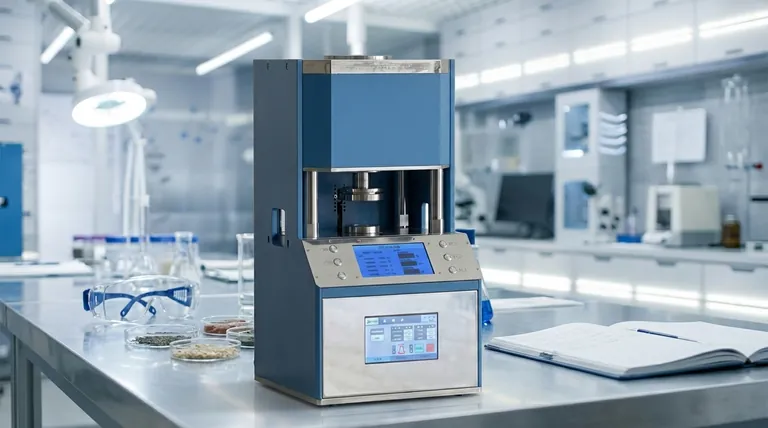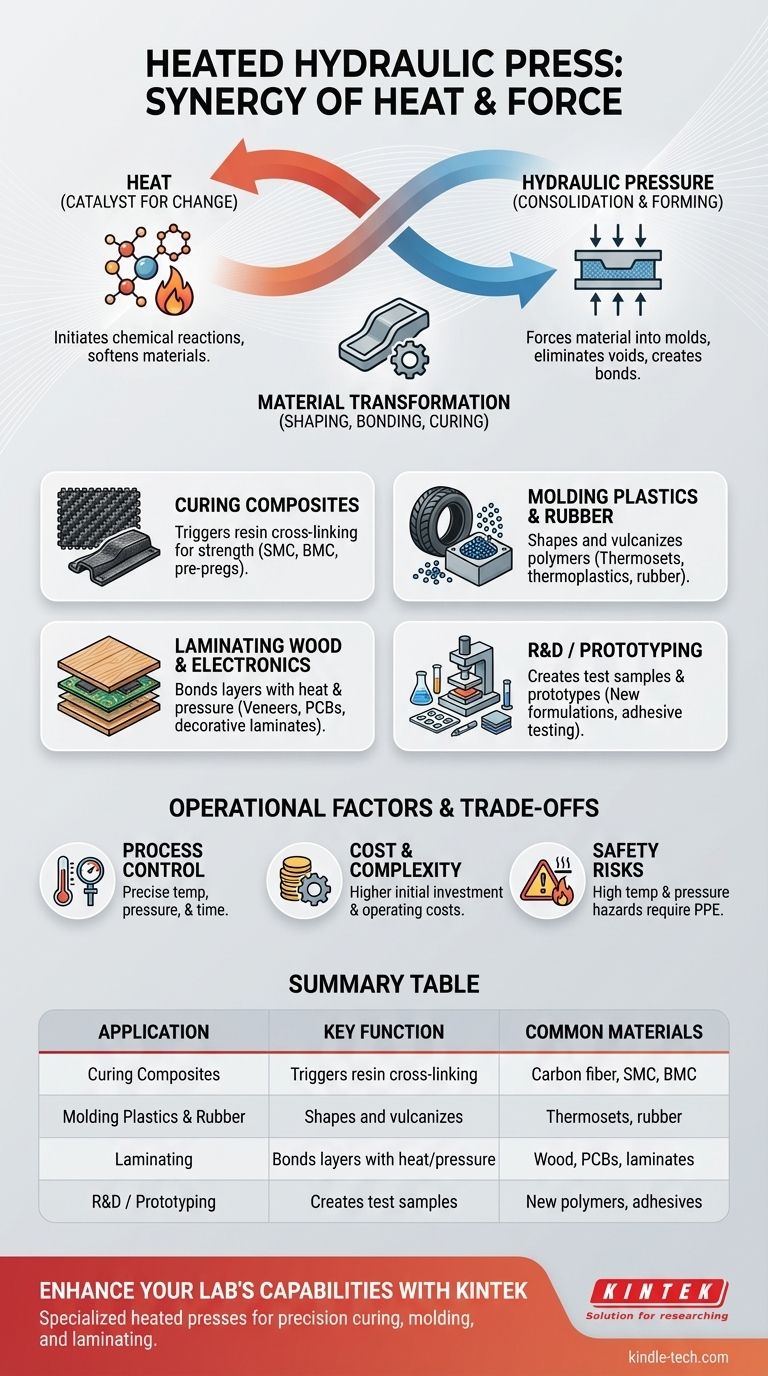At its core, a heated hydraulic press is a specialized manufacturing tool that uses immense, uniform pressure combined with precisely controlled temperature. It is primarily used for processes that require materials to be shaped, bonded, or chemically altered, such as curing advanced composites, molding plastics and rubber, and laminating wood or electronic components.
The true value of a heated press is its ability to manipulate materials at a molecular level. It uses heat to make materials pliable or to trigger chemical reactions (like curing), while simultaneously using pressure to consolidate the material, shape it, and eliminate imperfections.

The Fundamental Principle: Why Heat and Force Work Together
To understand the applications of a heated press, you must first understand the synergy between its two core functions: applying heat and applying force. They are not independent features; they work in concert to achieve specific material transformations.
Why Heat is a Catalyst for Change
Heat introduces energy into a material. This energy can initiate or accelerate chemical reactions, such as the curing of thermoset resins (like epoxy) or the vulcanization of rubber.
In other materials, like thermoplastics, heat increases molecular motion, causing the material to soften and become pliable. This allows it to flow and conform to the shape of a mold under pressure.
The Role of Hydraulic Pressure
The hydraulic system generates massive, evenly distributed force across large surfaces called platens. This pressure serves several critical purposes.
First, it forces a softened or liquid material to fill every detail of a mold. Second, it consolidates materials, squeezing out trapped air or volatile compounds to create a dense, void-free part. Finally, it ensures intimate contact between layers in a lamination process, creating a strong, permanent bond.
Key Industrial and Research Applications
The combination of heat and pressure makes the heated press an essential tool across numerous high-performance industries.
Curing Composite Materials
This is a primary application. A heated press is used for the compression molding of materials like Sheet Molding Compound (SMC) and Bulk Molding Compound (BMC), as well as for curing pre-preg carbon fiber or fiberglass layups.
The heat triggers the cross-linking of the polymer resin, giving the part its final strength and rigidity, while the pressure ensures full consolidation and a flawless surface finish.
Molding and Forming Plastics & Rubber
Heated presses are fundamental for the compression molding of both thermoset and thermoplastic polymers. A pre-measured amount of material is placed in a heated mold cavity, and pressure is applied to form the part.
It is also the standard machine for the vulcanization of rubber, where heat and pressure are used to cross-link the polymer chains, transforming the raw material into a durable, elastic product.
Laminating Wood and Engineered Panels
In the woodworking and furniture industries, large heated presses are used to manufacture plywood, particleboard, and MDF. Sheets of wood veneer or wood particles are coated with an adhesive (like urea-formaldehyde).
The press then applies heat to cure the adhesive rapidly while the pressure ensures a flat, stable, and solidly bonded panel. This same principle is used to apply decorative laminates to substrates.
Manufacturing Electronics
The creation of multi-layer printed circuit boards (PCBs) relies on heated lamination presses. Layers of copper foil and fiberglass pre-impregnated with resin are stacked together.
The press applies heat and pressure to cure the resin, fusing the layers into a single, solid circuit board.
Prototyping and Laboratory Research
On a smaller scale, laboratory heated presses are indispensable for materials science. Researchers use them to create standardized test plaques of new polymer formulations, test adhesive bond strengths, and prototype small-scale manufacturing processes before scaling up.
Understanding the Operational Trade-offs
While powerful, a heated press is not a universal solution. Understanding its limitations is key to using it effectively.
The Challenge of Process Control
The quality of the final part is entirely dependent on the precise control of three variables: temperature, pressure, and time. An incorrect heating rate, insufficient pressure, or improper cure time can lead to delamination, incomplete curing, or internal defects, rendering the part useless.
Initial Investment and Operating Costs
Heated presses are significantly more complex and expensive than their unheated counterparts. They require robust temperature controllers, high-wattage heating elements, and sophisticated insulation. The energy consumption to maintain high platen temperatures also contributes to higher operating costs.
Inherent Safety Risks
The combination of extremely high pressures and high temperatures (often exceeding 400°F / 200°C) presents significant safety hazards. Proper machine guarding, thermal insulation, personal protective equipment (PPE), and operator training are absolutely non-negotiable.
Making the Right Choice for Your Goal
To determine if a heated press is the appropriate tool, consider your final objective.
- If your primary focus is creating strong, lightweight composite parts: A heated press is essential for curing thermosets and achieving the consolidation needed for aerospace- and automotive-grade components.
- If your primary focus is producing large, flat, or thick-walled plastic/rubber parts: Compression molding with a heated press is often more efficient and effective than other methods like injection molding.
- If your primary focus is bonding layers of wood, laminates, or electronics: A heated press is the industry-standard tool for ensuring a fast, strong, and reliable bond across a large surface area.
- If your primary focus is materials development and testing: A laboratory-scale heated press is an indispensable and versatile tool for creating repeatable samples and exploring new material properties.
By understanding these core applications and principles, you can confidently assess whether the unique capabilities of a heated press align with your specific manufacturing or research objectives.
Summary Table:
| Application | Key Function | Common Materials |
|---|---|---|
| Curing Composites | Triggers resin cross-linking for strength | Carbon fiber pre-preg, SMC, BMC |
| Molding Plastics & Rubber | Shapes and vulcanizes polymers | Thermosets, thermoplastics, rubber |
| Laminating | Bonds layers with heat and pressure | Wood veneers, PCB layers, decorative laminates |
| R&D / Prototyping | Creates test samples and prototypes | New polymer formulations, adhesives |
Ready to enhance your lab's capabilities with a heated hydraulic press?
KINTEK specializes in high-performance lab equipment, including heated presses designed for precision curing, molding, and laminating. Whether you are developing advanced composites, testing new materials, or scaling up a production process, our expertise ensures you get the right tool for your specific needs.
Contact our experts today to discuss how a KINTEK heated press can drive efficiency and innovation in your laboratory.
Visual Guide

Related Products
- Automatic High Temperature Heated Hydraulic Press Machine with Heated Plates for Lab
- Automatic Heated Hydraulic Press Machine with Heated Plates for Laboratory Hot Press
- Manual High Temperature Heated Hydraulic Press Machine with Heated Plates for Lab
- Manual Heated Hydraulic Press Machine with Heated Plates for Laboratory Hot Press
- 24T 30T 60T Heated Hydraulic Press Machine with Heated Plates for Laboratory Hot Press
People Also Ask
- How much force can a hydraulic press exert? Understanding its immense power and design limits.
- What are the three applications of a hydraulic press? From Metal Forming to Lab Precision
- What is a hydraulic press machine used for? From Metal Forming to Lab Analysis
- What are heated hydraulic presses used for? Molding Composites, Vulcanizing Rubber, and More
- Does a hydraulic press have heat? How Heated Platens Unlock Advanced Molding and Curing



















